Steps toward language awareness in the workplace

The steps toward language awareness in the workplace offer tools for solving linguistic issues in a multilingual work community. They help to understand the different stages and levels of language awareness at a workplace and the time and financial resources required for operating in a language-aware way.
The steps also support reflection at the workplace: where are we now with language awareness and what kind of work community do we want to be?
It is important for workplaces to recognise and be aware of multilingualism, as doing so will improve the well-being of the work community. A language-aware workplace takes conscious and jointly agreed steps towards a functional multilingual work community and follows a language policy tailored for the company. It is recommendable to take it slow and reflect on what actions are appropriate to promote language awareness.
A workplace may also be English-speaking, but a language-aware work community gives employees the opportunity to learn and practise Finnish/Swedish as part of their work. This strengthens employees’ ability to integrate into Finnish society and experience inclusion even outside their role at work.
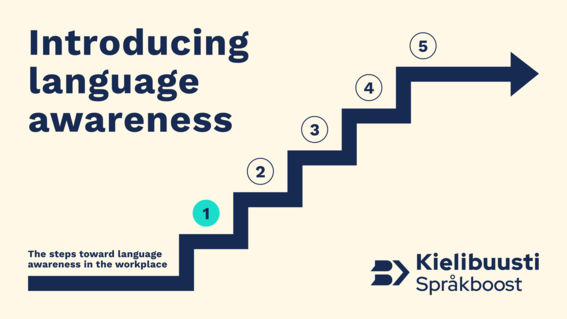
1. Introducing language awareness
The first step is to introduce the concept of language awareness. At this step, a workplace is characterised by one or more of these descriptions:
- The workplace has previously been Finnish- or Swedish-speaking, and international experts have now been recruited or will be recruited for the first time.
- The workplace has employees with different language backgrounds, but there have been no deliberate conversations on languages.
- Language issues have caused tensions or unclear situations in a multilingual work community, giving rise to a need to address the matter.
- The workplace has ended up only using English.
- The workplace does not support learning Finnish or Swedish; language learning is instead assumed to take place during employees’ free time or in language courses.
The step for introducing language awareness also involves starting to understand the linguistic challenges and wishes of the work community. One way of exploring language awareness is to invite an expert to explain what language awareness is and how it supports well-being at work.
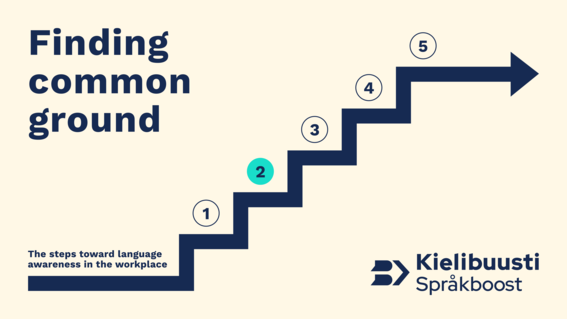
2. Finding common ground
The step of finding common ground focuses on discussing the language-related needs and problems at a workplace. Languages may have been discussed already at the step of introducing language awareness, but not in a structured way. The step of finding common ground makes a more conscious effort.
For finding common ground, concrete actions could include:
- Bringing up languages: which situations are linguistically straining for people and why? How could this strain be reduced?
- Mapping out the wishes of the work community. Who would like to use more Finnish/Swedish in their everyday work to learn more of these languages, and who would like to improve their professional English skills so that participating in English-language situations would make them less nervous?
- Discussing multilingualism and whether different languages could be used side by side as needed in some situations.
- Agreeing to reserve time for language practice in everyday life: for example a weekly lunch or coffee break in Finnish or Swedish only.
- Making voluntary language agreements that facilitate everyday life.
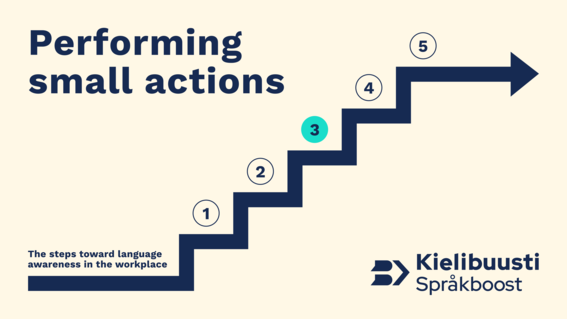
3. Performing small actions
At the step of performing small actions, the multilingualism of a workplace is acknowledged with maintained awareness through agreed practices. The practices are shared by the work community.
Possible practices include:
- Agreeing and noting down which languages are used in which situation
- Agreeing at the beginning of a meeting on how to use languages
- Greeting each other and catching up in Finnish before switching to English for work
- Agreeing on having certain coffee or lunch breaks in Finnish
- Making Finnish visible at the workplace, for example by naming key places and objects with notes (e.g. “neuvotteluhuone/neukkari”, “B-siipi”, “laturi”, “kaukosäädin”)
- Reserving one bulletin board for language questions – anyone can leave questions and anyone who has the time can answer them
Concrete sings of learning Finnish at a workplace make it a natural part of life at the work community.
With regard to resources, these small actions are not expensive. They are still valuable ways of increasing awareness and promoting language skills. By introducing even a small amount of Finnish in the everyday life of a workplace, the door to learning Finnish stays open.
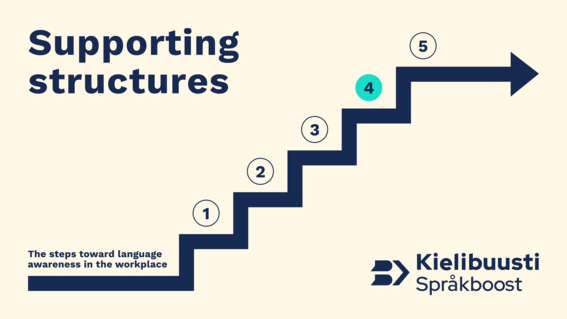
4. Supporting structures
At the step of supporting structures, the workplace supports employees’ Finnish proficiency systematically and over the long term. Resources are allocated to individuals’ language learning, and employees can study Finnish during work hours.
Measures suitable for the supporting structures step include:
- Not assuming that language learning only happens at external language courses, instead offering support at the workplace as well.
- Training Finnish-speaking employees to act as language support.
- Appointing a language mentor for each language learner.
- Discussing employees’ language goals regularly in development discussions.
- Following up on the achievement of language goals.
- Offering language learners tailored language training.
- Making efforts to keep oral and written communications at the workplace clear and comprehensible, for example by using plain language if necessary.
- Mapping out the actual language requirements of work tasks to take them into account in recruitment and the division of tasks.
- Employees sharing practices that support language learning with each other.
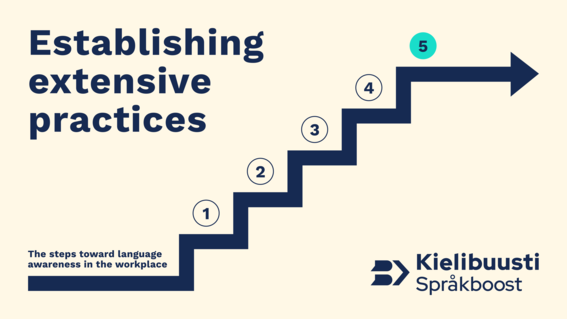
5. Establishing extensive practices
The step for establishing extensive practices is for a workplace that has versatile, jointly agreed policies related to using language, and these policies are documented and available to everyone. Language-related goals are for the entire work community, not just the individual. The workplace has had discussions on language to create a language strategy that everyone can access on a website.
The step for establishing extensive practices is defined by the fact that all types of language skills are recognised among employees and put to use. Language proficiency can also be rewarded with incentives such as language bonuses. The significance of languages for well-being at work is taken into account and recognised. The workplace also strongly supports language learners’ development.
At this step, the workplace has understood that achieving a language-aware operating culture requires investing money and time. Good practices are maintained and necessary resources are guaranteed with the support of leadership.
Video kielitietoisen työyhteisön portaista
Videolla Johanna Komppa kertoo, kuinka työpaikkojen kielitietoisuutta voidaan kuvata ja kehittää porrasmallin avulla. Video on tallenne Näin johdat monikielistä työyhteisöäsi -webinaarista (1.3.2023). Webinaari oli Suomen Yrittäjien ja Kielibuustin yhteistyötä.
©2023 Johanna Komppa, Eveliina Korpela, Lari Kotilainen, Salla Kurhila and Inkeri Lehtimaja.
Steps toward language awareness in the workplace, January 2023, by Johanna Komppa, Eveliina Korpela, Lari Kotilainen, Salla Kurhila and Inkeri Lehtimaja, is licensed under a Creative Commons Attribution 4.0 International License. The material can be found at kielibuusti.fi. Photos: All rights reserved.